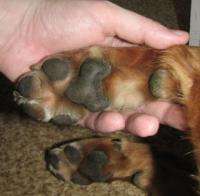The Bigger The Animal, The Stiffer The 'Shoes'

(PhysOrg.com) -- If a Tiger's feet were built the same way as a mongoose's feet, they'd have to be about the size of a hippo's feet to support the big cat's weight. But they're not.
For decades, researchers have been looking at how different-sized legs and feet are put together across the four-legged animal kingdom, but until now they overlooked the "shoes," those soft pads on the bottom of the foot that bear the brunt of the animal's walking and running.
New research from scientists in Taiwan and at Duke University has found that the mechanical properties of the pads vary in predictable fashion as animals get larger. In short, bigger critters need stiffer shoes.
Kai-Jung Chi, an assistant professor of physics at National Chung Hsing University in Taiwan ran a series of carefully calibrated "compressive tests" on the footpads of carnivores that have that extra toe halfway up the foreleg, including dogs, wolves, domestic cats, leopards and hyenas. She was measuring the relative stiffness of the pads across species - how much they deformed under a given amount of compression.
"People hadn't looked at pads," said co-author V. Louise Roth, an associate professor of biology and evolutionary anthropology who was Chi's thesis adviser at Duke. "They've been looking at the bones and muscles, but not that soft tissue."
Whether running, walking or standing still, the bulk of the animal's weight is borne on that pillowy clover-shaped pad behind the four toes, the metapodial-phalangeal pad, or m-p pad for short. It's made from pockets of fatty tissue hemmed in by baffles of collagen. Chi carefully dissected these pads whole from the feet of deceased animals (none of which were euthanized for this study), so that they could be put in the strain meter by themselves without any surrounding structures.
Laid out on a graph, Chi's analysis of 47 carnivore species shows that the area of their m-p pads doesn't increase at the same rate as the body sizes. But the stiffness of pads does increase with size, and that's what keeps the larger animal's feet from being unwieldy.
The mass of the animal increases cubically with its greater size, but the feet don't scale up the same way. "A mouse and an elephant are made with the same ingredients," Roth said. "So how do you do that?"
Earlier research had found that the stresses on the long bones of the limbs stay fairly consistent over the range of sizes, in part because of changes in posture that distribute the stresses of walking differently, Roth said. But that clearly wasn't enough by itself.
The researchers also found that larger animals have a pronounced difference in stiffness between the pads on the forelimbs and the pads on the hind limbs. Bigger animals have relatively softer pads on their rear feet, whereas in smaller animals the front and rear are about the same stiffness.
Chi thinks the softer pads on the rear of the bigger animals may help them recover some energy from each step, and provide a bit more boost to their propulsion. (Think of the way a large predator folds up its forelimbs and launches itself with its hind legs.)
"It is as if the foot pads' stiffness is tuned to enhance how the animal moves and how strength is maintained in its bones," Roth said.
The research appears today in the Journal of the Royal Society, Interface. It was supported by the National Science Foundation.
Chi has new work under way that looks at the construction of the human heel in the same ways.
More information: “Scaling and mechanics of carnivoran footpads reveal the principles of footpad design," Kai-Jung Chi and V. Louise Roth, Journal of the Royal Society Interface. doi:10.1098/rsif.2009.0556
Provided by Duke University

















